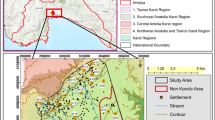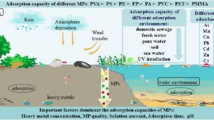Abstract
Changes to groundwater hydrodynamics and chemistry can lead to colloid release that can have a major impact on the groundwater environment. To analyze the effects of colloid release caused by artificial groundwater recharge, field and laboratory tests on colloid characterization and colloid release were conducted. The field tests were carried out at an artificial recharge test site in Shandong Province. In the field investigation, one recharge water sample and five groundwater samples were collected and filtered through three levels of ultrafiltration membranes, with pore sizes of 0.45 μm, 100 kDa, and 50 kDa. The field results indicated that the colloid mass concentrations in groundwater retained between membranes with pore sizes of 100 kDa–0.45 μm and 50 kDa–100 kDa were 19 and 62 mg/L, respectively. In recharge water, the colloid mass concentrations retained by 100-kDa–0.45-μm and 50-kDa–100-kDa membranes were 3 and 99 mg/L, respectively. Colloids detected on the ultrafiltration membranes were mainly inorganic between 100 kDa and 0.45 μm, and mainly organic between 50 and 100 kDa. Based on the field colloid investigation results, the organic colloid was chosen in the laboratory experiments to reveal its release behavior under different conditions. Porous media diameter, flux, ionic strength (IS), and ion valence were changed to determine their influences on organic colloid concentration outflow from undisturbed porous media. The experiment’s results indicate that decreasing the diameter, and increasing the flux, ionic strength, and the number of divalent cations, can promote organic colloid release. The organic colloid release rate in the early stage was high and is thus likely to affect the quality of groundwater. The results provide a useful scientific basis for minimizing changes to hydrodynamic and hydrochemical conditions during artificial recharge, thus safeguarding groundwater quality.











Similar content being viewed by others
References
Addiscott TM, Rose DA (1978) Chloride leaching in the Rothamsted drain gauges: influence of rainfall pattern and soil structure. Journal ofSoil Science 29:305–314. doi:10.1111/j.1365-2389.1978.tb00778.x
Arthur JD, Dabous AA, Cowart JB (2005) Water–rock geochemical considerations for aquifer storage and recovery: Florida case studies. Dev Water Sci 05:327–339. doi:10.1016/S0167-5648(05)52024-0
Baumann T, Fruhstorfer P, Klein T, Niessner R (2006) Colloid and heavy metal transport at landfill sites in direct contact with groundwater. Water Res 40(14):2776–2786. doi:10.1016/j.watres.2006.04.049
Bekhit HM, El-Kordy MA, Hassan AE (2009) Contaminant transport in groundwater in the presence of colloids and bacteria: model development and verification. J Contam Hydrol 108(3–4):152–167. doi:10.1016/j.jconhyd.2009.07.003
Bendersky M, Santore MM, Davis JM (2015) Statistically-based DLVO approach to the dynamic interaction of colloidal microparticles with topographically and chemically heterogeneous collectors. J Colloid Interface Sci 449:443–451. doi:10.1016/j.jcis.2015.02.031
Bradford SA, Yates SR, Bettahar M, Simunek J (2002) Physical factors affecting the transport and fate of colloids in saturated porous media. Water Resources Research 38(12). doi:10.1029/2002WR001340
Bradford SA, Torkzaban S, Kim H, Simunek J (2012) Modeling colloid and microorganism transport and release with transients in solution ionic strength. Water Resour Res 48(9):77–86. doi:10.1029/2012WR012468
Bradford SA, Torkzaban S, Leijand F, Simunek J (2015) Equilibrium and kinetic models for colloid release under transient solution chemistry conditions. J Contam Hydrol 181:141–152. doi:10.1016/j.jconhyd.2015.04.003
Cote CM, Bristow KL, Ross PJ (2000) Increasing the efficiency of solute leaching: Impacts of flow interruption with drainage of the "preferential flow paths". J Contam Hydrol 43:191–209
Degueldre C, Pfeiffer HR, Alexander W, Wernli B, Bruetsch R (1996) Colloid properties in granitic groundwater systems. I: sampling and characterisation. Appl Geochem 11(5):677–695. doi:10.1016/S0883-2927(96)00036-4
Degueldre C, Scholtis A, Pearson FJ, Laube A, Gomez P (1999) Effect of sampling conditions on colloids and ground water chemistry. EclogaeGeologicaeHelvetiae 92(1):105–114
Grolimund D, Borkovec M (2005) Colloid-facilitated transport of strongly sorbing contaminants in natural porous media: mathematical modeling and laboratory column experiments. Environmental Science & Technology 39(17):6378–6386. doi:10.1021/es050207y
Grolimund D, Borkovec M (2006) Release of colloidal particles in natural porous media by monovalent and divalent cations. J Contam Hydrol 87(3–4):155–175. doi:10.1016/j.jconhyd.2006.05.002
Grosberg AY, Nguyen TT, Shklovskii BI (2002) Colloquium: the physics of charge inversion in chemical and biological systems. Rev Mod Phys 74(2):329–345. doi:10.1103/RevModPhys.74.329
Gschwend PM, Reynolds MD (1987) Monodisperse ferrous phosphate colloids in an anoxic groundwater plume. J Contam Hydrol 1(3):309–327. doi:10.1016/0169-7722(87)90011-8
Ilg K, Siemens J, Kaupenjohann M (2005) Colloidal and dissolved phosphorus in sandy soils as affected by phosphorus saturation. J Environ Qual 34(3):926–935. doi:10.2134/jeq2004.0101
Iwatsuki T, Furue R, Mie H, Ioka S, Mizuno T (2005) Hydrochemical baseline condition of groundwater at the Mizunami underground research laboratory (MIU). Appl Geochem 20(12):2283–2302. doi:10.1016/j.apgeochem.2005.09.002
Kaminski MD, Goldberg MM, Mertz CJ (2005) Colloids from the aqueous corrosion of aluminium-based nuclear fuel. J Nucl Mater 347(1):88–93. doi:10.1016/j.jnucmat.2005.07.010
Masciopinto C (2006) Simulation of coastal groundwater remediation: the case of Nardo fractured aquifer in Southern Italy. Environ Model Softw 21(1):85–97. doi:10.1016/j.envsoft.2004.09.028
Masciopinto C (2013) Management of aquifer recharge in Lebanon by removing seawater intrusion from coastal aquifers. J Environ Manag 130:306–312. doi:10.1016/j.jenvman.2013.08.021
McLay CDA, Cameron KC, McLaren RG (1991) Effect of time of application and continuity of rainfall on leaching of surface-applied nutrients. Aust J Soil Res 29:1–9. doi:10.1071/SR9910001
Mccarthy JF, Zachara JM (1989) Subsurface transport of contaminants. Environ.Sci. Technol 23(5):496–502. doi:10.1021/es00063a001
Miller RJ, Biggar JW, Nielsen DR (1965) Chloride displacement in Panoche clay loam in relation to water movement and distribution. Water Resour Res 1:63–73. doi:10.1029/WR001i001p00063
Nyhan JW, Drennon BJ, Abeele WV, Wheeler ML, Purtymun WD, Trujillo G, Herrera WJ, Booth JW (1985) Distribution of plutonium and americium beneath a 33-yr-old liquid waste disposal site. J Environ Qual; (United States) 14(4):501–509. doi:10.2134/jeq1985.00472425001400040009x
Ouyang Y, Shinde D, Mansell RS, Harris W (1996) Colloid-enhanced transport of chemicals in subsurface environments: a review. Critical Reviews in Environmental Science & Technology 26(2):189–204. doi:10.1080/10643389609388490
Pazmino E, Trauscht J, Johnson WP (2014) Release of colloids from primary minimum contact under unfavorable conditions by perturbations in ionic strength and flow rate. Environmental Science &Technology 48(16):9227–9235. doi:10.1021/es502503y
Pettersson C, Ephraim J, Allard B (1994) On the composition and properties of humic substances isolated from deep groundwater and surface waters. Org Geochem 21(94):443–451. doi:10.1016/0146-6380(94)90096-5
Ryan JN, Elimelech M (1996) Colloid mobilization and transport in groundwater. Colloids & Surfaces A Physicochemical & Engineering Aspects 107(95):1–56. doi:10.1016/0927-7757(95)03384-X
Ryan JN, Gschwend PM (1990) Colloid mobilization in two Atlantic coastal plain aquifers: field studies. Water Resour Res 26(2):307–322. doi:10.1029/WR026i002p00307
Torkzaban S, Bradford SA, Wan J, Tokunaga T, Masoudih A (2013) Release of quantum dot nanoparticles in porous media: role of cation exchange and aging time. Environmental Science & Technology 47(20):11528–11536. doi:10.1021/es402075f
Teng Y, Su J, Wang JS, Dan N, Li J, Song L, Zuo R (2014) Soil microbial community response to seawater intrusion into coastal aquifer of Donghai Island, South China. Environmental Earth Sciences 72(9):3329–3338. doi:10.1007/s12665-014-3236-3
Ticknor KV, Vilks P, Vandergraaf TT (1996) The effect of fulvic acid on the sorption of actinides and fission products on granite and selected minerals. Appl Geochem 11(4):555–565. doi:10.1016/0883-2927(96)00011-X
Torkzaban S, Bradford SA, Van Genuchten MT, Walker SL (2008) Colloid transport in unsaturated porous media: the role of water content and ionic strength on particle straining. J Contam Hydrol 96(1–4):113–127. doi:10.1016/j.jconhyd.2007.10.006
Torkzaban S, Bradford SA, Vanderzalm JL, Patterson BM, Harris B, Prommer H (2015) Colloid release and clogging in porous media: effects of solution ionic strength and flow velocity. J Contam Hydrol. doi:10.1016/j.jconhyd.2015.06.005
Vanderzalm JL, Page DW, Barry KE, Dillon PJ (2010) A comparison of the geochemical response to different managed aquifer recharge operations for injection of urban stormwater in a carbonate aquifer. Appl Geochem 25(9):1350–1360. doi:10.1016/j.apgeochem.2010.06.005
Vendelboe AL, Schonning P, Moldrup P, Jin Y, Merbach I, de Jonge LW (2012b) Colloid release from differently managed loess soil. Soil Sci 177(5):301–309. doi:10.1097/SS.0b013e3182506dd3
Vendelboe AL, Moldrup P, Schonning P, Oyedele DJ, Jin Y, Scow KM, de Jonge LW (2012a) Colloid release from soil aggregates: application of laser diffraction. Vadose Zone J 11(1):120–128. doi:10.2136/vzj2011.0070
Zhang W, Ying H, Yu X, Dan L, Zhou J (2015) Multi-component transport and transformation in deep confined aquifer during groundwater artificial recharge. J Environ Manag 152:109–119. doi:10.1016/j.jenvman.2015.01.027
Acknowledgements
This research was funded by the National Natural Science Foundation of China (Grant no. 41472215). The authors would like to thank the journal editors and the reviewers for the valuable comments that improved the paper considerably. We would also like to thank the staff at the Shandong Hydraulic Research Institute for their assistance in the field.
Author information
Authors and Affiliations
Corresponding author
Additional information
Responsible editor: Philippe Garrigues
Rights and permissions
About this article
Cite this article
Zhou, J., Liu, D., Zhang, W. et al. Colloid characterization and in situ release in shallow groundwater under different hydrogeology conditions. Environ Sci Pollut Res 24, 14445–14454 (2017). https://doi.org/10.1007/s11356-017-8856-1
Received:
Accepted:
Published:
Issue Date:
DOI: https://doi.org/10.1007/s11356-017-8856-1




